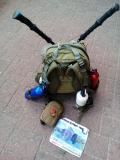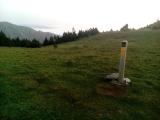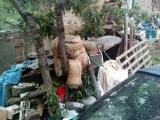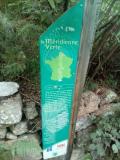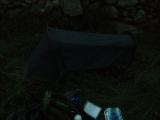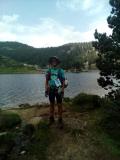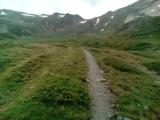Tuesday, July 19th. 2016 - Day 0
This is the very start of this first edition of the Transpyrénéa. The sun has been largely shining this moring. I've been refueling with sugar and cakes, completing my already-taken-at-the-hotel breakfast. Yesterday I had dinner with Géraldine, Martine and Christian. Géraldine and Martine are racing, while Christian is crewing them. I've been showing out my legendary appetite, eating a giant salad, a large pizza, and a good ol' banana split. You need serious stuff to power a Christian like me. I know how to race ultras. But I can't race them on thin air. Waiting for the start, I exchange a few words with Japanese racers. We talk about the weather, compare our bags. I explain them my view on the local weather : sun, heat, storm, sun, heat, storm. Repeat. Looks like I was quite visionnary. But this is all too easy, this is just oh-so-typical weather on the French side of the Pyrénées in summer.
So well, here we start. We jog gently. I, for one, mostly walk, lenghtening my stride, and when it goes downhill, I simply do not force myself to walk, but let my legs naturally jump from one stone to another. I chat with Laurent Thezé and Tony Gout, we are about the same level, and what's more, we share that simple point of view "it's no use to get tired now, we get over 500 miles in the moutain to show what we're capable of, so just, simply, wait". We're openly at the back of the pack by now. I have a doubt on my water storage. I filled up everything up to the limit, so that's 3 good liters of fresh water, but still, this is a nasty sun, it's hot, we're gonna be dried up pretty soon. Hopefully there's a water point just after the start, slightly on the left of the course, and it's signaled by some race official, so we can't miss it. This is really welcome, I drink plenty and refill everything.
At this stage, the course is relatively flat, easy, simple. Without any real interest, told me Tony, who has been hiking this part during Spring. But hey, these are easily earned miles, I have no doubt we're going to meet more serious difficulties ahead. And I know how to be patient. Here comes CP1 (check-point one). Looks like everyone is on fire here. I have my chip validated. This very chip I almost lost at Le Perthus. Since then, I have secured it with some plastic strap on my bag. That would be stupid, to loose the chip in the mountain, hey? I eat some quick snacks, fill my bottles with water, and go again. And I complete this "refill of my bottles" with a "refill of my shoe". Indeed, there's a little stream to cross, and crossing it, I manage to slip on a stone and stick my left foot deep in the water. One has to know that I started the race with traditionnal hiking shoes, all made of leather, the exact model is Badile, by Meindl. They look like your grandpa shoes, the very ones he used to go out in the mountain. I love them, they protect your feet, up to the ankle, and they are relatively water-proof. Until the water goes way over the ankle, because at that point they just store the water inside, with as much efficiency as they would normally keep it outside. It does not dry up that well. So with that hot weather, I just managed to have a completely wet left foot. Now Christian, this is just great, there was *one* blunder not to make, and you did it. I hesitate to change socks. But I finally decide this is only the beginning, let the mistakes accumulate for a while until I do act and change something, I might do something even worse in the following minutes.
We pass Wouter, he's in trouble, looks like he's about to quit. This is sad, I sadly can't lend him a pair of new legs. He knew before the start that it was going to be complicated, he had trouble preparing for this. I chat with another fellow runner and we find out, exchanging ideas, that I'm the author of that little Excel file he found on Facebook, with the distances, elevations and estimated times between each stage on the course. The race director did share such a file, but with a rougher granularity, considering only officiel check points (CP) and major stations ("BV", stands for "Base-Vie" in French, litterally "Life-Base"). Mine has a finer grain, it has several hundred lines, about one point every hour, so this allows you to realize "OK, now it's gonna be up for an hour and a half, then down for 50 minutes", etc. It's a valuable information, which I found very convenient, and I collected it by copying, with my own little hands, the official "Topo-Guides" (hiking reference books) of the GR10. According to those guides, in terms of pure hiking time, there's about 350 hours to go from Le Perthus to Hendaye. This does not include the time lost at the refreshment areas, the time lost sleeping, and so on. This means that considering an average 4 hours break for sleeping, per day (that's to say only 3 hours of real sleep) one has to power hike, at least 10% or 15% faster than a "regular" hiker. And those who have tried out the course before the race warned us: whereas on some sections the times announced by the books are realistic, on some sections, most specifically the second section in the "Ariège" sector, they are really challenging. You could power hike and sweat and to your best and end up with just the default, expected time. Well, I'll see that when I'm there. Even now, as surprising at it might seem, I can already spot some racers who are cooling down along the path, looks like they are alrady overheating. Damn, this is only the very beginning.
Night is coming. I consider going to sleep. I have my tent in my backpack. I could wait until the "Refuge de Batère" to sleep. Or plant my tent now. I hesitate. I see another runner who's sleeping right on the path, without any tent whatsoever, just a plain outer bag over his sleeping bag. Yet another runner whistles from behind. Am I lost? Mmm, I might be. I waste some time in the forest trying to find my way around some minor stream. And, doing this, I just stumble on the perfect spot to set up my tent. As I am slightly off road, no one is gonna bother me here. So I get the tent out of my bag and get it ready for its cannonical use: sleep. It takes me 15 minutes, just like in my garden when I tried it out. I make a little blunder by capturing some nasty itching plants between the inside and outside layers. Oh well, forget it, let it be that way... Now since I took the tent, I did not take the sleeping bag. I had to choose, weight is a cruel decision maker. I could have, by spending some more money, taken both of them. But just to give you an idea, a 1400g tent like the one I have is worth 130 euros. An 800g tent is more likely yo cost 600 euros. Same kind of story for the sleeping bag, I have a "good one" but not an "absolutely-super-light one". But this is not so bad, to protect myself from the cold when sleeping at night, I can always use the good ol' fashion "plut all your clothes on". So I slip into my rain paints, to heat-up my legs, since a pair of shorts is obviously not enough. But as I am tired, and do this in the dark, I mess up and put it upside down, I zip the wrong part. So it's like I'm wearing some very baggy stuff, with legs getting together at the height of my knees. My butt feels cold. In short, it's a failure. Anyway, I wake up 3 hours later. Sleep was not perfect but even that way I still think it was better than the experience of other runners, trying to sleep in crowded common rooms or tents. Yes, this is still the beginning of the race so the pack is quite dense yet.
Wednesday, July 20th. 2016 - Day 1
I arrive at Batère with a clear mind as I've already slept. I eat plenty and head forward again, with a splendid sunrise on the mountain. I feel this GR10 and me are made for great adventures together. We arrive in the Canigou sector. The Canigou is known as the most significant summit on the Eastern part of the French Pyrénées. As I unserstand it, there are several possible allowed variants of the GR10 over here. I do not really know which one to choose so I decide to stick on the one that is closest to the GPS track. I do not want to improvise now and follow the GR using the red and white marks only. Apparently the variant I'm not following would mean a shorter path but more ascent and descent. I'm not running after elevation, going uphill and downhill is not what I'm best at, so there's no need to overdo it. I'm a long distance runner, the thing I'm good at is "when it lasts for a long time" and this is basically why I'm participating in this race. But as far as the mountain is concerned, I'm neutral, I could to the same thing on plain roads, I wouldn't mind, it would probably be as magical as far as I'm concerned. I know this might sound shocking for all of you mountain lovers but hey, here's my coming out "yes, I do admit it, trails do not make any difference for me, be it a narrow path in the mountain or a major straight road in a plain, I don't care, as long as I can move along it for hours, days and weeks, I'm likely to enjoy it".
I buy a couple sandwiches in a refuge. It's good to have those extra food supplies along the road. Because, yes, honestly, the 6 000 kcal recommanded by the race director are a joke. As far as I'm concerned, 6 000 kcal is what I need on a daily basis. So for a stage like Le Perthus - Merens, I probably need up to 20 000 kcal, and for longer stages such as Ariège (stage 2) or Central Pyrénées (stage 3), 30 000 kcal might be closer to the reality. All in all, to complete the whole race, 100 000 kcal is quite realistic. This represents 5 or 6 kg of food to start from Merens or Luchon, or, put another way, between 15 and 20 kg for the complete event. Luckily enough, there are of course the official CPs and BVs, and additionnally, refuges, sometimes even restaurants and villages. But not that often, I mean, you need to keep an eye on your food levels when going solo on this race. I fear some sectors. OK, buy eating my stock (7 000 kcal per BV, + 1 000 kcal spare) I can last a whole day, even a day and a half, but after that, I could be in deep trouble. This is the main difference between solo and crewed runners. I need to always carry about 1 500g of food "just in case". Should I be confident I could refill within 12 or 24 hours, I would have saved a lot of weight.
I now move along with a little group of runners. I go downhill to Mantet with them. We chat. Night comes soon. I try and find a nice spot for my tent. Indeed, I've had a look on the upcoming profile: we're gonna climb. So I'd rather sleep now at a low altitude on rather flat ground, than try to plant my tent in the rocks somewhere near 6 000 feet of elevation. I ain't crazy. I finally find the very perfect spot. Protected from major winds by a small stone wall, just beside the path but sufficiently isolated so that most people won't even notice I'm here. I set up my camp and as I enter the tent I realize its bottom is just very high because of the tall grass under it. Once I lie down in it, this grass transforms itself in a soft and awesomely comfortable mastress. I sleep like a baby. The ring gets me up quite abrupetly. I chose a quite dynamic music by James Brown. One two three four get up ! (starts at second 11) Get all up... Get up ! Get all up... Impossible to stay asleep. I pack my stuff and double-triple check that I do not forget anything in the grass. It would be an awfull blunder to forget part of my equipment here, I do carry a heavy bag, but there's nothing in it I consider useless. Hey, this is Patrice Fayol, a guy I've been scouting around a few months ago when trying out the Ultrathletic Ardèche course. I hike alone, for what should be a long climb, with a few intermediary downhills, and at the very end a big big downhill on Merens and BV1 (the first major aid station).
Thursday, July 21st. 2016 - Day 2
CP5 in Bolquère. Funny geographical setup, we're on a high plateau, it almost seem we're at the bottom of a valley near sea level, but the altimeter says the contrary. It's no surprise professionnal French cyclists commonly spend some time over here to maximise their blood red cell rate. It's hot. Before arriving at the CP, we cross villages. I stop at a local store and buy some fruits and 6-pack of ice cream cones. I eat 4, give one to a fellow runner who's just nearby, and give the last one to a lady who's waiting along the course. She promises to offer it to the next racer passing by. Once at the CP, I meet Cédric Fontaine, who knows me because he fixed my feet at the 6 days in Privas, walking. I have a harder time recognizing him but I acknowledge at Privas I was quite tired and did not pay the required attention to all people. So at the CP, I have my feet checked by a doctor. Globally, they are OK, thanks to my hiking shoes, which protect them quite well. Still, I have a little problem on my left foot. The big toe nail stands on top of a giant blister. The consequence is quite obvious: this to nail is gonna go off. The only question is: "when?". Looks like this should happen during the race, normally, it happens afterwards, but this race is so long it changes the deal. The doctor pierces, empties and dries the blister, puts some strapping on it, and here we go again! I'm still a little worried, this is a f*cking big nail, almost half an inch wide, and it's not gonna go off without being noticed. Is this a coincidence: this happens on my left foot, the very one I did wet at the beginning of the race just after CP1. Just a coincidence...
The runner who has won "my ice cream" before CP5 is Laurent Thezé. I have spent a bunch of time at the starts of the Tor des Géants so we get to know each other a little bit. We meet Cédric near the Bouillouses. This is just the typical family hike place and time: a great artificial lake, with restaurants and bars nearby, serving food and drinks, gentle paths following the bottom of an old flat valley created by some ancient glacier. We enjoy the restaurants, rewarding ourselves with a good sandwich and an ice cream.
I head toward the final climb before BV1. Cédric and Laurent are ahead, I can't follow their rythm. Or, more precisely, I refuse to heat the machine up and get tired trying to match their pace. This path is supposed to bring us up to 7 500 feet, the highest point of this stage. And I'm not disappointed up there. After meeting a bunch of magnificent cows, I end up in what could be summarized as "big rock paradise". I even get the chance to walk on snow, and have my feet go through the snow, thanks to my heavy and akward stride. Snow that goes up your shoe and down your sock, melting into cold water, is just someone you need to experience. The downhill is quite exceptionnal too. Especially knowing that the sun is going down, and it's quite dark. I'm trying to find my path. Yet another aspect of running "solo", I always keep my headlight in low energy mdoie, else I would have to charge it all the time, and this is plain impossible. So I try and find the white and red marks of the GR, check with the GPS that I'm more or less on the right track, but in this rock fiesta, quite steep, 20 yards on the left or 20 yards on the right does make a hudge difference. At some point I slide in the snow. At least, this is funny. I realize I'm going to be late at BV1 for sleeping. So I should, ideally, find a sleeping spot before. The "Refuge des Bésines" seems to be exactly at the right place. Now the question is: "will it be open?". Anyone there to welcome us? It happens the people running the refuge are there, serving sodas to those who order them, and they allow me to sleep right in the main room, wherever I can manage to lie down. This is perfect for me, I fall asleep immediately. Wake up 3 hours later, the standard sleep time on this race, as far as I'm concerned, and... and the road again!
Friday, July 22nd., 2016 - Day 3
The downhill is less tricky than the upper rocky part of the mountain. I'm quite pleased to arrive in Merens. There I still manage to make an orienteering blunder, I miss a red and white mark and get on the wrong side of the river, on its left. A lady in a van helps me and tells me to get back on the other side. Thanks m'am! We cross the racers who are going back on the race, from BV1, as it seems to reach BV1 it's a single road we need to go one way then the other, backwards.
At BV1, it's raining. And as it's a camping site, it looks gloomy. Those who already spent a few weeks vacation under the rain know what I'm talking about. The race organization has been criticized for this major checkpoint's quality. Some event went to talk about "base de mort" (litterally "deatch base" instead of "life base" in French). This is frankly exagerated. The motto here is not comfort, but efficiency. Period. Formally, everything you would ever need is available: my bag with my personnal stuff, some food, a clean place to take a shower, tents to take a nap. But hell, yeah, it's pouring a not-so-entertaining rain outside. What did you think? That this was a holiday camp on some romantic Southern Mediterranean Island ? No kidding... I insist: on all the fundamental points, there was everything you needed. Now, one needs to be able to appreciate the good side of life, be positive.
I take a shower. I change gear. And it takes me ages. I decide to switch shoes. I do like my Meindl, but let's face it, they did cost me a toe nail already. And there's one more thing: I'm dead slow. I had planned some intermediary times, and I'm already half a day (something like 12 hours...) behind. I do think that with my spare pair, the model being Hoka Tor Ultra, I can move slightly faster as they are lighter. I did not put them on on day one because I suspect 500 miles is too much for that time of shoes: they would never handle the whole thing. These are good choose, I tried them and warmed them up on the 6666, they consist of a very soft trail base, along with some somewhat high ankle protection, sort of a hybrid between a trail shoe and a hiking shoe, combining the best of both worlds. I also get rid of my solar charger. It does not charge fast enough. Sorry for the planet, but I'm gonna switch back to classical one-use batteries as far as the GPS is concerned. I need 12 of them, to last 6 days. Yeah, 6 pairs of LR06 AA batteries does weight something significant. I also change socks, underwear, shorts and t-shirts. The rest of my clothes unchanged. Last minute tunning: I decide to leave my tent in my spare bag, and carry the sleeping bag instead. The tent in itself is good but it has a drawback I did not anticipate: it's not practical to set it up under then rain as you have to set the inside up before the outside. OK OK this is a beginner's blunder but hell, this is, to some extent, what I am. A beginner. This tent has been very usefull and valuable at the beginning of the race anyway, as it allowed me to sleep alone and quietly, far from the crowd of the official CPs and other mountain refuges. It's a bet. And, what's more, the sleeping bag is lighter than the tent. We'll see anyway.
I go to the medical tent to pass the tests held by those Italian researchers. They study what "deep fatigue" is about, as far as I understand. So I smell different tubes and try and answer my best, they study my hard, blood pressure, whatever. They are very nice and do not force me to take off my shoes to step on their magical weight machine that guesses both your weight and your fat/muscle ratio. No kidding, I just spent considerable amount of times preparing my toe with a clean strap, it's not to mess everything up now by pulling my socks away. Note that I did it a little differently than the doctor at CP5. I basically put a quite standard piece of bandage, so that nothing sticks on the junction between to nail and the skin, then I strap it with adhesive stuff (known as "élasto" over here). This way, it's protected, and I do not yell and cry when pulling the bandage and strapp off.
Now, I'm ready to go.
Next page: Stage 2, Merens - Luchon
